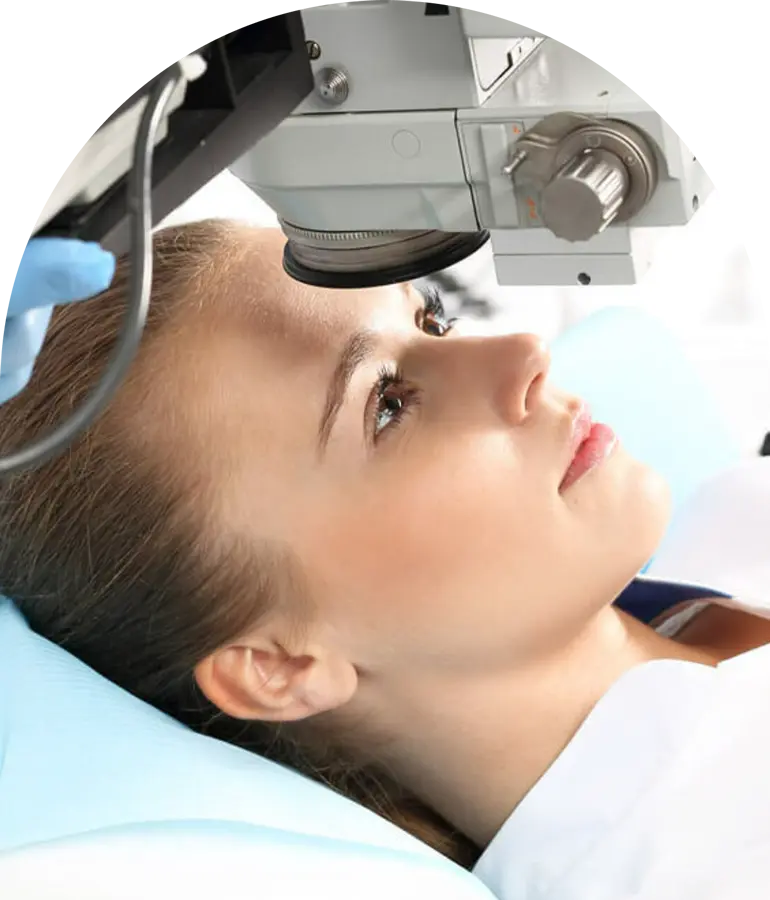
LASIK Surgery – An Overview
LASIK (Laser-Assisted In Situ Keratomileusis) surgery revolutionised the field of refractive correction, offering millions of people worldwide an opportunity to attain clearer vision without the dependency on glasses or contact lenses. This innovative procedure involves using advanced laser technology to reshape the cornea, addressing common refractive errors like near-sightedness, farsightedness, and astigmatism.
LASIK surgery is renowned for its precision, speed, and effectiveness, often resulting in rapid visual improvement and minimal discomfort. With its remarkable success rates and relatively quick recovery, LASIK continues to be a popular choice for those seeking freedom from visual aids and enhanced quality of life.
Laser Vision Correction
Get rid of your glasses
Laser vision correction is by far the best option to eliminate the dependency on glasses and contact lenses. The shape of your cornea attributes to your eye power. You could have myopia (short-sight), hypermetropia (long-sight) or astigmatism (blurry vision) depending on the point where the light from an object you see gets focussed inside your eyes.
During a laser vision correction surgery, the shape of your cornea is altered in such a way that light entering into the eye is focused at the right spot on the retina. This is a simple procedure and takes less than ten minutes from start to finish. Also, you’ll be able to resume your normal life on the same day.

Laser Vision Correction – Options
Laser vision correction has evolved rapidly over the last twenty years. LASIK is the most popular refractive error correction surgery and can rectify a power of -1D to -9D in myopia patients and up to +6D in hypermetropia and astigmatism patients.
In LASIK, a motorized blade is used to create a flap of the first two layers of the cornea, and a computer-controlled laser is used to reshape the inner layers. FEMTO LASIK is a blade-free approach where a specialized laser is used to create this flap and then reshape it. ReLEx SMILE has come in as the next advancement and is bladeless and flapless with much faster recovery.
What are the Types of LASIK Surgery?
LASIK/ ULTRALASIK
This is the traditional LASIK procedure where the corneal flap is created using a microkeratome. The corneal tissue underneath the flap is then reshaped using an excimer laser to correct the refractive error.
Femto LASIK
Also known as bladeless LASIK or all-laser LASIK, this procedure employs a femtosecond laser to create the corneal flap instead of a microkeratome blade. Femto LASIK is considered to have potentially less complications and more precise flap creation compared to blade LASIK.
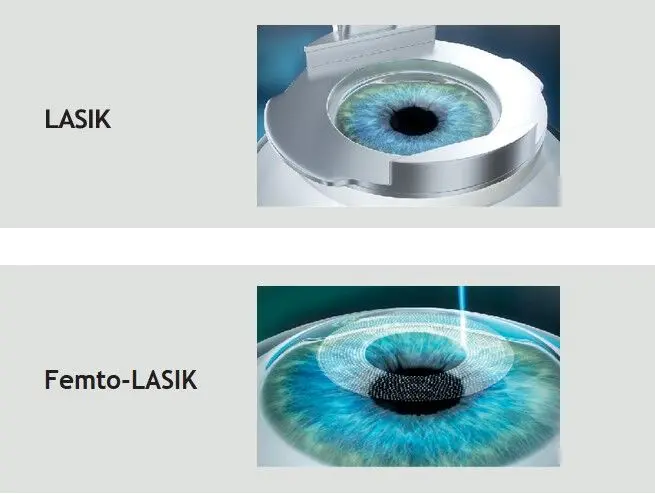


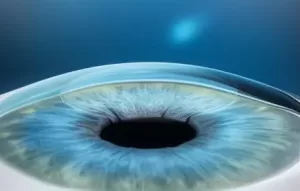
SMILE (Small Incision Lenticule Extraction)
While not technically LASIK, SMILE is a minimally invasive refractive surgery that corrects vision by creating a small, lens-shaped piece of tissue (lenticule) inside the cornea, which is then removed through a small incision. SMILE may offer advantages such as quicker recovery and reduced risk of dry eye compared to traditional LASIK.
These are the four main types of LASIK surgery, each with its own unique approach and potential benefits. Patients should discuss with their eye surgeon to determine the most suitable option based on their individual needs and eye conditions.
What are the Symptoms Indicating Refractive Errors That Can be Corrected by LASIK Surgery?
- Blurred Vision
Difficulty seeing objects clearly due to myopia, hypermetropia and Astigmatism.
- Difficulty with Night Vision
Increased glare, halos, or difficulty seeing in low-light conditions, especially for those with higher levels of refractive error.
- Eyestrain
Strain or discomfort in the eyes, particularly after prolonged periods of reading, computer use, or other visually demanding tasks.
- Headaches
Some individuals may experience headaches, especially if they are squinting or straining to see clearly due to uncorrected refractive error.
- Distorted Vision
Objects may appear distorted or misshapen, especially in individuals with astigmatism.
- Squinting
People may find themselves squinting to try to see more clearly, particularly at a distance or in challenging lighting conditions.
- Difficulty with Activities
Difficulty performing certain activities, such as driving, playing sports, or reading, due to uncorrected refractive errors.
Benefits of LASIK Surgery
- Improved vision without glasses or contacts.
- Quick results, often experienced within days.
- Reduced dependence on visual aids.
- Enhanced quality of life and convenience.
- Better peripheral vision and overall visual awareness.
- Increased self-confidence and self-esteem.
- Rapid recovery with minimal discomfort.
- Long-lasting results.
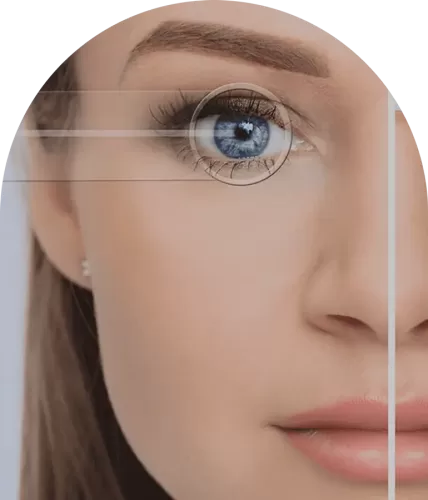

Why Choose Roya Eye Clinic for LASIK Surgery?
- Experienced Surgeons
Our team comprises highly skilled and experienced LASIK surgeons who have performed thousands of successful procedures, ensuring you receive top-quality care and expertise.
- State-of-the-Art Technology
At Roya Eye Clinic, we utilise the latest and most advanced LASIK technology, to ensure optimal outcomes for our patients.
- Personalised Care
We understand that every patient is unique, which is why we provide personalised care tailored to your individual needs and concerns throughout every step of the LASIK journey, from consultation to post-operative follow-up.
Lasik Eye Surgery Procedure
- Preoperative Preparation
Before your LASIK surgery, you’ll undergo a comprehensive eye examination to assess your candidacy for the procedure. Our team will discuss your medical history, perform corneal measurements, and address any questions or concerns you may have. You’ll also receive detailed instructions on how to prepare for surgery, including any necessary precautions and medication.
- Surgical Process
On the day of your LASIK procedure, you’ll be greeted by our friendly staff and made comfortable in our state-of-the-art facility. The surgery itself typically takes just a few minutes per eye and is performed under topical anaesthesia. Our experienced surgeons will use advanced laser technology to create a corneal flap and reshape the underlying corneal tissue to correct your refractive error. Throughout the procedure, your safety and comfort are our top priorities.
- Post-operative Care
Following LASIK surgery, you’ll receive thorough instructions for post-operative care to ensure optimal healing and visual recovery. Our team will monitor your progress closely and schedule follow-up appointments to assess your vision and address any concerns. Most patients experience improved vision within days of surgery, with minimal discomfort and a rapid return to normal activities.
At Roya Eye Clinic, we’re committed to providing exceptional LASIK surgery with the highest standards of care, expertise, and technology. Your journey to clearer vision starts here.
FAQ
For most patients, the results of LASIK surgery will last forever, however, while the effects of a laser eye treatment (LASIK treatment surgery) are permanent, the benefits can decrease over time.
– Eye disease that causes the cornea to thin and bulge, such as keratoconus.
– Systemic medicines preventing the complete recovery of the cornea.
– Systemic conditions: like uncontrolled diabetes or conditions wherein the collagen level in the body is not normal, for example, the Marfan syndrome.
– Refractive error which is outside the range of laser vision correction
– Pregnant and breastfeeding women
Any patient 18 years old and above can proceed with refractive surgery, there is no upper limit for LASIK, and the surgery depends on the eye health of the individual, in addition to the visual needs.
LASIK eye operation is not painful. Before starting the procedure, the surgeon will use numbing eyedrops for both your eyes. While there might be a feeling of pressure during the ongoing procedure, there will be no feeling of pain.
If you go for a LASIK surgery procedure, the doctor will require an initial baseline evaluation to determine if you are a suitable candidate for the laser eye operation.
It can be normal to experience slight dryness or a feeling of tired eyes on the day of the procedure. The eyes are kept comfortable post-procedure by a surgeon-guided regimen of medicated drops and artificial tears, post-procedure, rest for 24 hours, and stay inside on the day of laser treatment. you can resume your sports activity the next day.
Yes. The procedure needs you to look into the target green light of the laser to identify the centre of your vision. Our surgeons are excellent at talking to you throughout the procedure. We use eye drops to numb your eyes and you will not feel any pain during the procedure.

Refractive Surgery
Refractive surgery is a surgical procedure performed to correct the refractive error of the eye. It is usually done to get rid dependence on glasses or contact lenes. It can be performed in a patient with stable refractive error after the age of 18 years.
Complete medical history along with detailed eye examination is mandatory in all candidates.
The current refractive procedure can be classified as corneal procedures and lens-based surgery.
Corneal procedures:
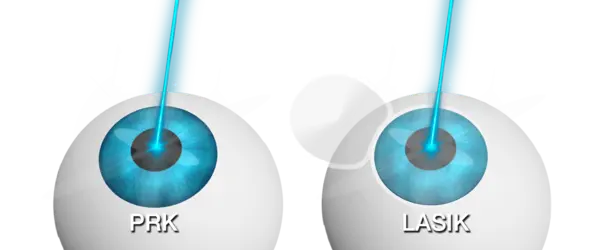
PRK Vs LASIK
1- PRK (Photrefractive Keratectomy)
This procedure involves careful removal of the top most layer of the cornea also known as epithelium, this is followed by Excimer laser delivery which reshapes the corneal surface – to correct the refractive power of the eye. A contact lens is placed for a few days to support the healing of the eye, the epithelium is very thin (50 microns) and usually grows back within 3 days.
2- LASIK/ ULTRALASIK
This is the traditional LASIK procedure where the corneal flap is created using a microkeratome. The corneal tissue underneath the flap is then reshaped using an excimer laser to correct the refractive error.
3- Femtosecond LASIK:
This is a specialised laser which creates a flap precisely at the desired depth, it is very different from Excimer laser described above and hence needs a separate machine for delivery. Femtosecond laser assisted LASIK is also known as FEMTO- LASIK.
After the flap is created it is lifted and the residual bed is then treated with Excimer laser. At the end of the procedure the flap is reposited back in place, on the corneal bed and patient is discharged with medication.
4- Refractive Lenticule Extraction – ReLEX SMILE / FLEX
This is the most advanced refractive surgery and requires only Femtosecond laser (same laser as described in FEMTO -LASIK). Refractive power of the eye is corrected by using femtosecond laser to create a lenticule (of predetermined size and thickness) within the layers of the cornea. This lenticule can then be extracted in two ways
- Through a 4-5mm incision -this is called Femtosecond Lenticule Extraction (FLEX).
- Through a very small 2mm incision – this is known as Small Incision Lenticule Extraction (SMILE)
Extraction of this lenticule results in altered shape of the cornea and corrects the refractive power. This surgery does not need Excimer laser, Microkeratome blade or flap hence it is popularly known as blade-less, flap-less refractive surgery.
